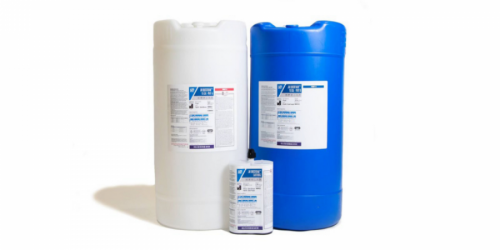Q&A Forums
Spray Foam Shrinkage Problems! Post New Topic | Post Reply
| Author | Comments |
|---|---|
|
Matt Brown
Posted: Sep 27, 2011 01:20 PM
|
Spray Foam Shrinkage Problems!
We recently build a new home back in 2010. We had closed-cell spray foam sprayed on the ex terior walls, in the attic and on our ceiling. The foam was applied in temperatures probably averaging 75, with no excessively hot days or humid days during applications. This was in the fall months. On our ceiling we had applied 2" of foam directly onto the drywall lid and then had about 16" of dry cellulose sprayed over this. When the spray foam was applied to the drywall ceiling we started having problems with the 5/8" thick drywall cupping upwards between the trusses that were spaced at 2' apart. The cupping was a substantial 5/8" difference. This was causing the drwall screws to pop and was causing the drywall seams to crack, that had been taped. We cut into the ceiling and found that the foam that had been applied to the ceiling was shrinking away from the trusses and pulling up on the drywall that it was adheired to, and making the drywall "cup" between the trusses where it was fastened. To head off the problem with the drywall we installed a metal channel directly over the drywall and applied a new drywall ceiling throughout the house. We also had spray foam applied to an exposed wall that separates our great room from an unfinished bonus room. Within a month of the spray foam being applied in the attic and on this wall, we noticed some shrinkage of the foam on this exposed wall. This particular wall is a 2x4 wall framed with conventional #2 hem fir studs. A couple more months went by and we noticed still more shrinkage. We called the company that installed the foam and they came out and chinked the cracks where the spray foam had pulled away from the studs, where you could see the drywall on the other side. The separation at this point varied from 1/4" to 2" pulling away from the side of the studs and up to 3' in length-wise down the stud. We continued to monitor the situation and it appeared that it was not going to move much more. We were wrong.... 8 months after the spray foam was installed we checked on this exposed wall that had been foamed. It was now in the middle of summer and our days were probably averaging 85 to 90. The foam that had been applied on this wall was now shrunk even more. It now had very obvious signs that something was very wrong. The foam had continued to shrink and pull away from the studs and also had begun to twist as it was shrinking and was beginning to pull away from the drywall on the finished side of the studs. The foam started out by filling a void of 16" wide by 3 1/2" thick between the studs. It had now shrunk down to a width of about 12" and a thickness of about 1 1/2". The length of the gaps are almost continuous from the bottom of the studs to the top now. The foam is hard to the touch and does not really give any when pressed on. At this point in time we wondered if the foam that had been applied on our ceiling and exterior walls was doing the same thing. We pulled back the cellulose and found that the foam applied to the ceiling was still continueing to shrink even more. We cut into our exterior wall and found the same thing happening. The foam was shrinking and pulling away from the exterior OSB and the LSL TimberStrand studs that it was applied to. Again it is hard to the touch and does not give any when pressed on. Do you have any ideas on what might be causing this or why this is happening? When we take samples of the foam what should we be testing for or looking for? Do you think that this foam may be harmful and may need to be removed? Any thoughts on this matter would be great! |
|
mason
Posted: Sep 27, 2011 04:12 PM
|
This is typical of the type of cases I am hired to investigate. Most often this type of foam shrinkage problem is caused by the foam having a combination of poor dimensional stability of the foam and good adhesion to the substrate. The poor dimensional stability can typically be traced to an application problem that creates high exothermic heat within the foam (spraying it too thick) which causes the foam to have weaker cells and more open cells. Consequently the foam tends to shrink. As it shrinks it exerts pressure that can distort the drywall. The best way to reduce this pressure is to cut into the middle of the space between the wood joists and let the foam shrink for a week or so. Then cut back the foam at a 45 degree angle to the substrate and re-spray foam in 1 inch lifts. I have found this repair procedure to be very effective without having to remove all of the foam. In most cases, you only have to remove 10-15% of the foam to stabilize the foam Of course, I would have to do an onsite inspection to determine if your problem is similar enough to the applications I have been involved in to make a definitive repair recommendation. Back to your original question. Cut some samples of the foam, see if the foam has a lot of open cells, distorted cells, discolored foam in the middle of the lift, fissures, cracks or blow holes in the foam. This is all indications of high exothermic heat. Check the density and compressive strength. A 2 lb density foam should spray in place 2.2 to 2.5 (or higher) density. Just weigh it and do the calculations. The compressive strength should be around 20 to 30 psi. This is the equivalent of having to press hard with your thumb on the foam to depress it 10%. Call me if you need additional assistance 571-239-5221. Also check out my article on Troubleshooting Problem SPFA Applications on my website, masonknowles.com. |
|
Bob Silverman
Posted: Sep 27, 2011 09:32 PM
|
I don't think that spraying foam 2" to the top of the drywall is sprayed too thick to cause excessive exotherm. After the contractor came out to do his initial repair, have you called him back? Has their been a rep from the foam manufacturer to come and look at the job? Are they aware of it? I had some foam shrink on a job a few years back and my distributor came to look at it. He was very proactive in helping me get the manufacturer to step up to the plate and help with the repair. Everyone has issues from time to time, it is how everyone handles the issues that counts. Just my opinion. Bob |
|
mason
Posted: Sep 28, 2011 03:50 PM
|
Good advice from LongTimeLurker. It doesn't neccesarily have to be caused by excessive thickness. Other factors can cause the foam to have too many open cells and poor dimensional stability (poor mix, pressure/heat issues, equipment problems, and a lot of other things. However, I have been on many jobs that called for only 2 inches of foam but after looking at the application, observed 3-4 inches of foam where the sheathing and the framing members meet. At these areas there was obvious signs of too much exothermic heat and the foam shrinks away. Regardless of the causes, the repair recommendations I made work in most cases. By the way, sometimes even 2 inches can be too thick depending on the type of foam and the conditions. To be sure, before installing any foam spray 3 separate lifts of foam on some plywood at 1, 2 and 3 inch lifts. Wait a few minutes and measure the temperature of the interior of the foam with a meat thermometer. The interior temperature should be between 160 to 220 degrees F. If it is higher, then the foam's physical properties are most likely to be affected negatively. |





























